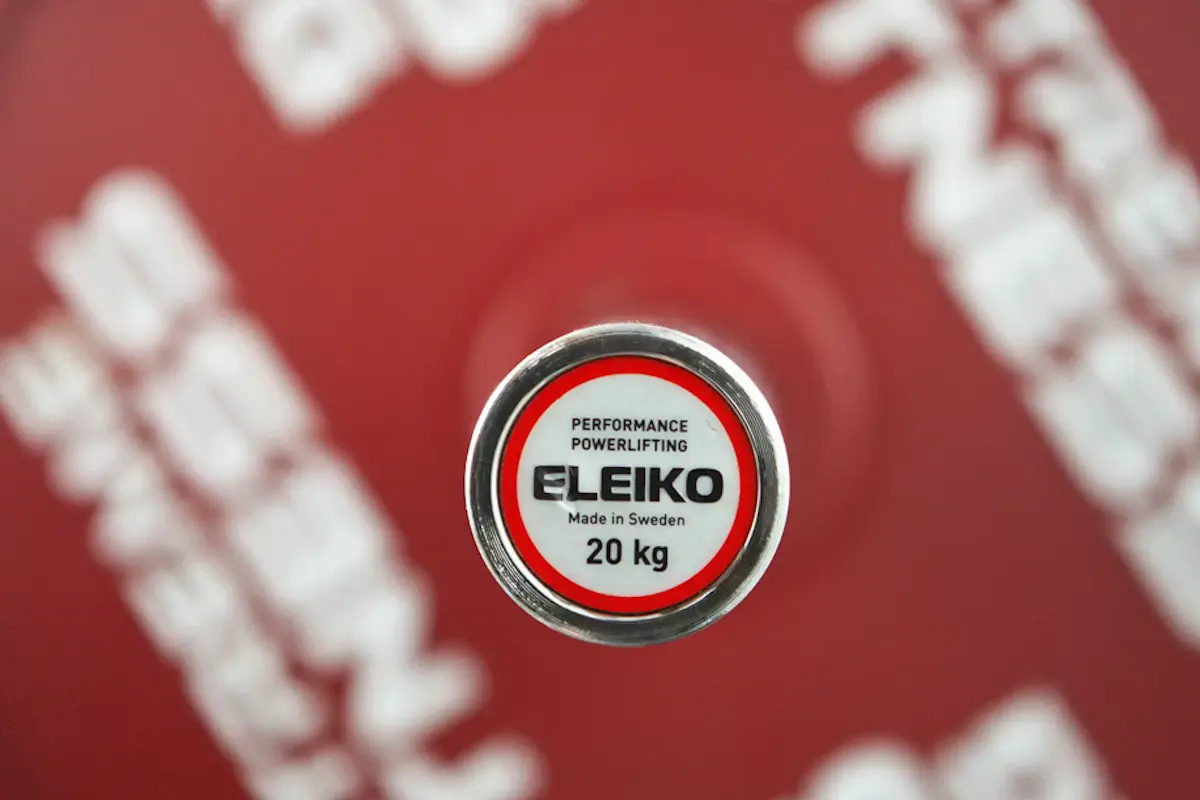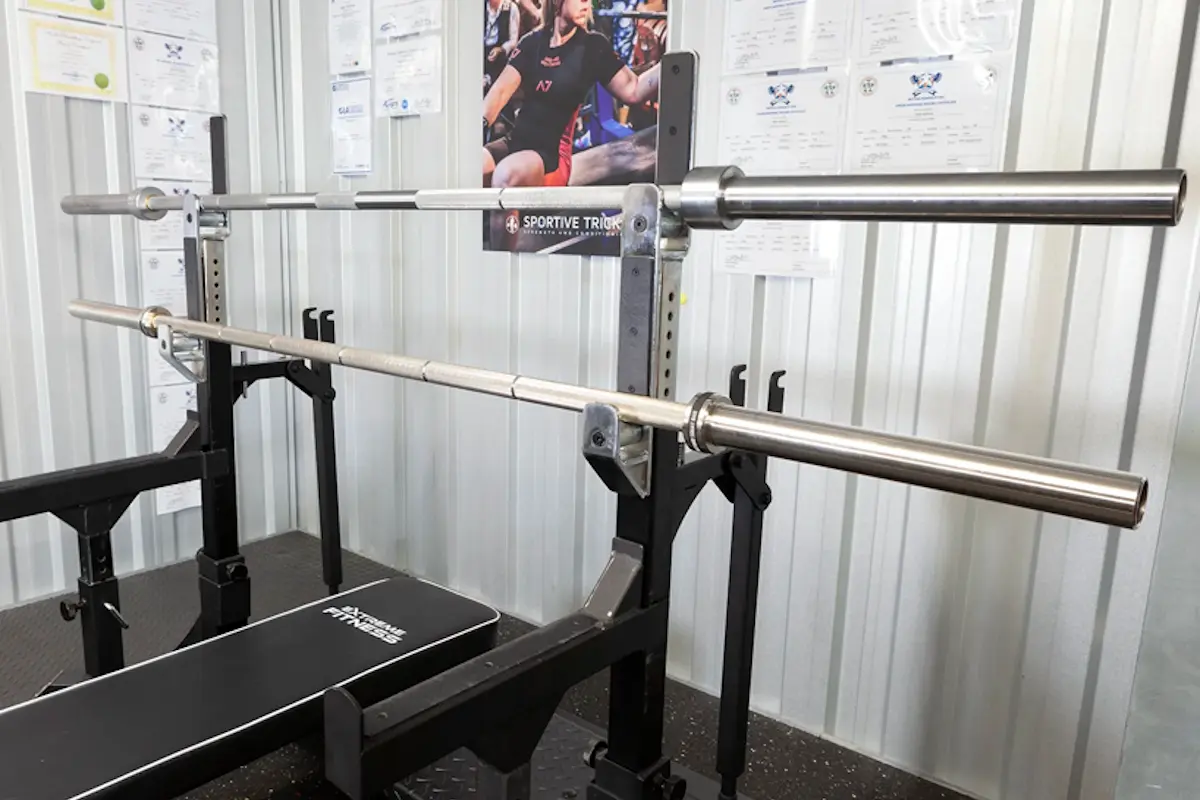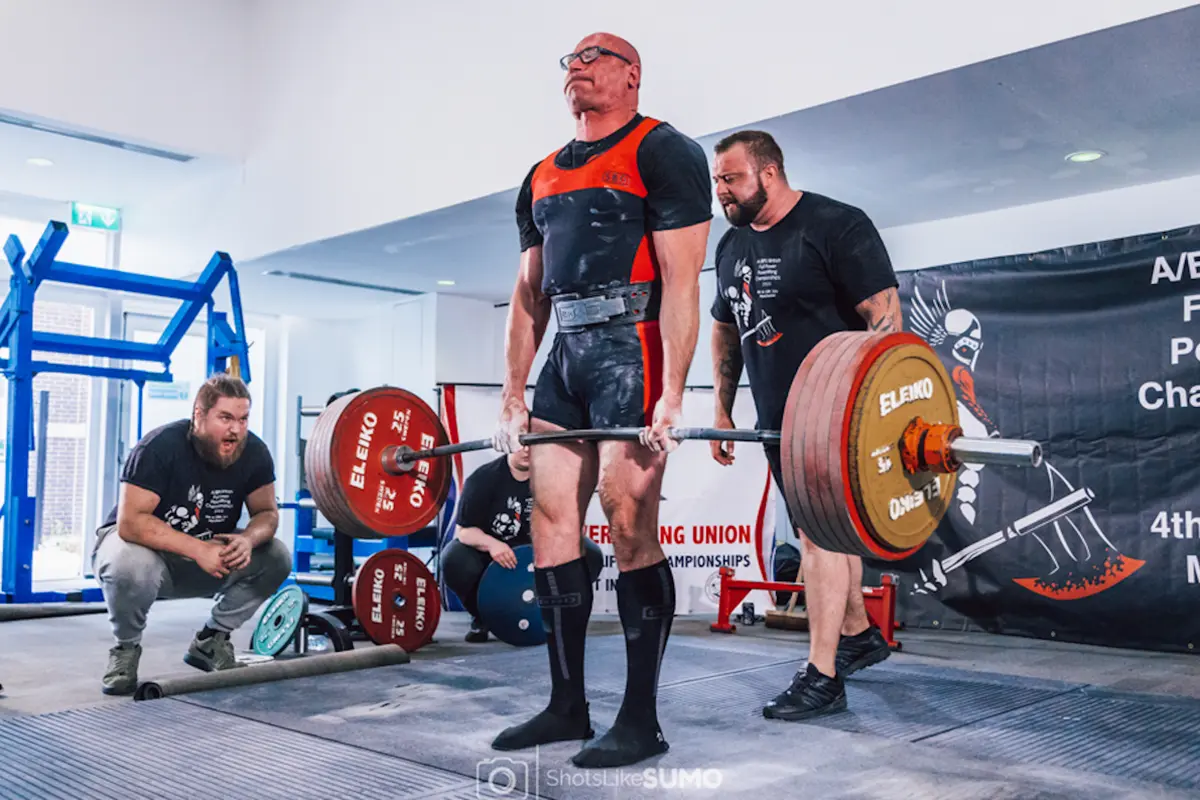The Anatomy of a Powerlifting Barbell

What's In This Article
- Key Highlights
- Introduction
- What Makes a Powerlifting Barbell Unique?
- Specialized Powerlifting Barbells
- Choosing the Right Barbell for You
- Tips on maintaining a powerlifting barbell.
- Conclusion
- Frequently Asked Questions
- References and Resources
Key Highlights
- Different powerlifting federations have varying barbell requirements, with some allowing specialized bars for different lifts.
- The aggressive knurling pattern on powerlifting bars prioritizes grip security over comfort, especially for deadlifts.
- The 32mm and 35mm Squat Bars are designed for squatting with minimal whip, weighing 25kg and longer than standard powerbars.
- The Deadlift Bar is thinner (27-28mm) with lower tensile strength, allowing for more flex when pulling heavy weights off the floor.
- Regular maintenance, including cleaning the knurling, proper storage, and rust prevention, is crucial for preserving a powerlifting barbell's performance and longevity.
Introduction
Powerlifting is a strength sport that relies on the right tools, like the barbell, to excel in any home gym or commercial gym. Choosing the correct barbell isn't just about preference; it affects performance, safety, and progress, especially considering the price range. This article guides beginners through powerlifting barbells, outlining their essential features and benefits.
Louie Simmons, founder of Westside Barbell, emphasized the importance of using stiff powerlifting bars for training. His gym, known for breaking over 140 world records, relies on these bars to prepare lifters for competition.
Understanding a powerlifting barbell is key. These barbells are specialized for the squat, bench press, and deadlift in powerlifting. Details like knurling and whip significantly impact performance under heavy weights.
Powerlifting carries more injury risks than standard strength training, so strong and specific equipment is paramount (Serafim et al., 2023). A 2023 study by Ntoukas et al. on head and neck cancer survivors demonstrated the feasibility and safety of a heavy lifting strength training (HLST) program when conducted under supervision and with proper equipment.
This research highlights that even for populations with specific health concerns, powerlifting can be safe when appropriate equipment measures are taken.
What Makes a Powerlifting Barbell Unique?
Understanding the whip in a powerlifting barbell requires appreciating how tensile strength influences this characteristic.
- Tensile strength, essentially the maximum stress a material can tolerate while being stretched or pulled before necking, plays a pivotal role in a barbell's behaviour under load.
- In powerlifting barbells, tensile strength is a critical factor. A barbell's tensile strength is quantified in pounds per square inch (PSI), and it determines the bar's capacity to flex or whip under heavy weights.
- Higher tensile strength in a barbell equates to greater rigidity and less whip. This is particularly desirable in squats and branch presses.
- For example, a power bar with a tensile strength of around 190,000 PSI will have significantly less whip than an Olympic barbell, which might have a tensile strength closer to 160,000 PSI.
- The increased tensile strength means a squat bar can handle greater weights without bending.
- Therefore, the tensile strength of a barbell is not just a technical specification; it's a critical component that defines the barbell's performance characteristics in powerlifting. Selecting a barbell with the appropriate tensile strength is crucial for lifters looking to optimize their training and performance in this sport.

Different powerlifting federations have varying requirements regarding specifications.
- For instance, the International Powerlifting Federation mandates using a single IPF powerlifting competition bar for all three lifts.
- Federations, including the World Powerlifting Congress (WPC), permit different bars for different lifts - specifically a 25kg, 32 mm or 35mm squat bar for squats and a more flexible Texas deadlift bar for deadlifts, which can significantly impact lifting mechanics and maximum weights achieved.
- Grant Broggi, a Starting Strength Coach, notes that IPF powerlifting bars have less whip, which is noticeable when squatting heavy weights. He recommends training with a 29mm bar to prepare for powerlifting meets, as it can add a few pounds to lifts on competition day when using a thinner bar.
- All federations use competition barbell collars.
The knurling pattern on these bars is equally crucial.
- Powerlifting bars typically feature aggressive knurling - a sharp, diamond pattern cut into the steel - which provides the secure grip necessary for handling maximal loads.
- While Olympic weightlifting bars often have smoother knurling to accommodate the dynamic movements of weightlifting, powerlifting bars prioritize grip security over comfort, particularly in the deadlift, where maintaining hold of the bar is paramount.
Specialized Powerlifting Barbells
Powerbar
- The Powerbar is known for its stiffness, aggressive knurling, and a standard diameter that suits most grip styles.
- The stiffness of the Powerbar, a key attribute, allows for minimal flex under heavy loads, making it ideal for exercises where stability is paramount.
- The aggressive knurling ensures a secure grip, a critical factor in executing lifts with heavy weights.
- It typically weighs 20kg
32mm Squat Bar
- The 32mm Squat Bar features a thick shaft diameter, explicitly designed for squatting, significantly reducing its whip.
- This characteristic is particularly beneficial when performing heavy squats, providing a stable and predictable lifting experience.
- The thicker bar also demands a firmer grip, which can contribute to overall forearm and grip strength development.
- The 32 mm Squat Bar weighs 25kg and is typically longer than a powerbar.
35mm Squat Bar
- Taking it further, the 35mm Squat Bar offers an even thicker diameter, delivering increased stiffness.
- This bar is specially tailored for power squats and can be an invaluable tool for lifters looking to specialize in this area.
- Its substantial diameter provides a unique grip challenge, aiding grip strength and endurance development.
- The 35 mm Squat Bar weighs 25kg and is typically longer than a powerbar.
Deadlift Bar
- The deadlift bar is 27-28 mm thick and has a lower tensile strength than a squat bar or even powerbar.
- The bar is specifically designed for pulling big weights off the floor and has a significant whip or flex under heavy loads.
- It is longer than a powerbar, which helps in optimal weight distribution for heavy deadlifts.
- It weighs 20kg

Safety Squat Bar
- The Safety Squat Bar stands out with its padded shoulder and arm supports, enhancing comfort and encouraging proper lifting form.
- This is designed to reduce shoulder stress, making it an excellent option for lifters with shoulder mobility issues or injuries (Falch et al., 2023).
- Its design also slightly shifts the weight, which can help develop better squat mechanics.
Bowbar
- Characterized by its curved design, the Bowbar allows for a more natural grip position.
- This design helps in reducing shoulder strain, a common issue among powerlifters.
- The Bowbar can be particularly beneficial for those with shoulder impingements or mobility limitations, allowing them to continue training while mitigating the risk of further injury.

Cambered Bar
- With its bend, the Cambered Bar introduces an element of instability in lifts.
- This feature helps develop stability and control, as the lifter must engage additional stabilizing muscles to maintain proper form.
- The Cambered Bar can be an effective tool for enhancing overall body awareness and muscular coordination.
Earthquake Bar
- Distinctly different from traditional barbells, the Earthquake Bar is highly flexible and often used with resistance bands.
- This is used mainly for stability training and muscle activation.
- The flexibility creates a dynamic lifting environment, forcing the lifter to engage the core and stabilizing muscles throughout the lift, which can lead to improved overall strength and stability.
Each of these specialized barbells offers unique benefits and challenges, allowing lifters to tailor their training to specific goals and preferences. These are some well-known and respected manufacturers:
|
Type of Barbell |
Manufacturer |
Manufacturer |
|---|---|---|
|
Powerbar |
Rogue Fitness |
Eleiko |
|
32mm Squat Bar |
Texas Strength Systems |
Ivanko Barbell Company |
|
35mm Squat Bar |
Titan Fitness |
CAP Barbell |
|
Deadlift Bar |
Texas Strength Systems |
Primal Strength |
|
Safety Squat Bar |
EliteFTS |
York Barbell |
|
Bowbar |
Strength Shop |
Watson Gym Equipment |
|
Cambered Bar |
Black Widow Training Gear |
Sorinex Exercise Equipment |
|
Earthquake Bar |
BandBell |
TDS Fitness Equipment |
Rogue Work Hardening™ (RWH™) is a patent held by Rogue for treating barbell shafts as one of the best ways to increase their durability. Their "F Rating™ is a durability scale for barbells based on functional testing at stresses similar to what barbells experience when being dropped.
A popular US option is the Barenaked Powerlifting Bar by Bells of Steel. The American Barbell Power Bar is a good option from American Barbell.
Zinc coating offers better wear and corrosion resistance than chrome and is generally tougher, making it a popular and affordable choice for mid-range barbells.
How Much is a Barbell to Buy?
- Budget Bar: <300 USD
- Mid Range Bar: 300-600 USD
- High Range Bar: 800-1200 USD
- Elite Bar: 1200+ USD
Choosing the Right Barbell for You
Factors to Consider
- Hand Size: The diameter of the barbell is crucial for grip comfort and effectiveness. Those with smaller hands may find a smaller diameter (around 28mm) more comfortable and easier to grip, while individuals with larger hands might prefer a thicker diameter (around 29mm to 32mm) for a better fit.
- Experience Level: Beginners are generally advised to start with a standard Powerbar. Its balanced features, such as moderate diameter and knurling, provide an excellent introduction to powerlifting without overwhelming the novice lifter. As experience and strength levels increase, specialized bars can be introduced to target specific lifts or training goals. Most experienced lifters will have a favorite bar!
- Training Focus: If the focus is on improving specific lifts, choosing a specialized kit can be beneficial. For instance, those focusing heavily on squats might opt for a squat bar, while a lifter focusing on improving grip strength could benefit from one with more aggressive knurling.

Recommendations for Beginners
- Starting with a versatile and standard power multipurpose barbell is advisable for beginners in powerlifting. A bar weighing 20 kilograms and a diameter allowing a firm, comfortable grip is ideal. An Eleiko IPF powerlifting bar is a good option.
- This type of barbell will serve well across all basic lifts and provide a solid foundation for learning and progress. It's also beneficial for beginners to spend time with different types of barbells to get a feel for their preferences and needs as they evolve in the sport.
- Look for quality with the best value. Some manufacturers provide a lifetime warranty or free shipping.
Tips on maintaining a powerlifting barbell.
Maintaining a powerlifting barbell is essential to ensuring its longevity and performance.
- Regular Cleaning: Sweat and chalk can accumulate on the barbell, leading to corrosion over time. It's recommended that the barbell be cleaned after each session. Use a brush to remove chalk from the knurl and wipe down with a mild detergent or disinfectant.
- Proper Storage: Store the barbell horizontally on a rack to prevent warping or bending. Ensure the storage area is dry to avoid rusting, especially if the gym is in a basement or garage with high humidity.
- Check for Rust: Inspect a stainless steel or chrome barbell regularly for rust, particularly in the knurling and sleeves. If rust is spotted, it can often be removed with light brushing and applying a rust inhibitor.
- Lubrication: The sleeves of the barbell should rotate smoothly. Periodically lubricating the bushings or bearings with a suitable lubricant can ensure consistent performance.
- Avoid Moisture Exposure: Even with rust-resistant coatings, prolonged exposure to moisture can damage a barbell. Keep the barbell away from wet floors, and consider using a dehumidifier in the gym if necessary.
Common Issues to Watch Out For
- Barbell Bending: Dropping a barbell loaded with heavy weights from a significant height, especially without bumper plates, can lead to bending. A bent barbell is unsafe for use, as it can unpredictably affect the weight distribution during lifts.
- Sleeve Damage: Improper loading and unloading of weights, wildly slamming, can damage the sleeves. This damage can affect the rotation of the sleeves and, ultimately, the barbell's performance.
- Rust and Corrosion: Storage in damp environments or improperly cleaning can develop rust. Rust not only degrades the barbell but can also impair grip and increase the risk of tetanus if the skin is broken.
Common Mistakes to Avoid
- Neglecting Regular Inspections: Failing to inspect the barbell regularly for signs of wear and tear can lead to safety hazards. Regular checks can help identify issues like bending, rusting, or wear in the knurling.
- Using Harsh Chemicals for Cleaning: Harsh chemicals can damage the finish and integrity of the barbell. It's essential to use mild cleaning solutions and avoid abrasive materials that can scratch or degrade the barbell's surface.
- Improper Handling and Use: Dropping the barbell from a height or using it for unintended exercises (like rack pulls on an unprotected rack) can cause premature wear or damage.
Conclusion
Understanding your powerlifting barbell is essential for your strength journey. Factors like weight, length, diameter, durability, and knurling impact your performance. Choosing the right one is crucial for efficiency and success in powerlifting.
Mike Tuchscherer, Adam Hires, and Josh Bryant, respected powerlifting coaches, are known for their online training programs that often incorporate specific barbell recommendations for improving lifters' numbers.
Maintenance, including cleaning, storage, and inspections, is key to preserving its lifespan and performance. Powerlifting starts with knowing your equipment well - the foundation of every lift you make.
Frequently Asked Questions
What's the difference between a powerlifting bar and an Olympic bar?
A powerlifting bar has a higher tensile strength (around 190,000 PSI vs 160,000 PSI), more aggressive knurling, and less whip than an Olympic one, making it more stable for heavy lifts.
How much does a standard powerlifting bar weigh?
A standard powerbar weighs 20kg, though specialized squat bars are typically heavier at 25kg.
How should I maintain my powerlifting barbell?
Clean the knurling with a brush after use, wipe down with mild detergent, store horizontally in a dry place, and regularly check for rust or damage.
Which barbell should I start with as a beginner?
Beginners should start with a standard 20kg powerbar, which offers balanced features and versatility for all basic lifts.
Why do some bars have different diameters?
Bar diameter affects grip comfort and stiffness - thicker diameters (32-35mm) provide more stability for squats, while thinner ones (27-28mm) allow more flex for deadlifts.
References and Resources
- Falch, H. N., Kristiansen, E., & van den Tillaar, R. (2023). A biomechanical comparison between Squatbar® and Olympic barbell. Biomechanics, 3(2), 258-266.
- Ntoukas, S. M., McNeely, M. L., Seikaly, H., O'Connell, D., & Courneya, K. S. (2023). Feasibility and safety of Heavy Lifting Strength Training in Head and Neck Cancer survivors post-surgical neck dissection (the LIFTING trial). Supportive Care in Cancer, 31(6), 348.
- Serafim, T. T., de Oliveira, E. S., Maffulli, N., Migliorini, F., & Okubo, R. (2023). Which resistance training is safest to practice? A systematic review. Journal of Orthopaedic Surgery and Research, 18(1), 296.
- Garage Gym Reviews
- Pullum Sports - Ultimate Barbell Buying Guide
- Bull Rock Fitness - Barbell Buying Guide
- International Powerlifting Federation